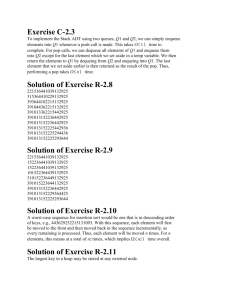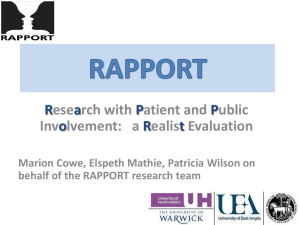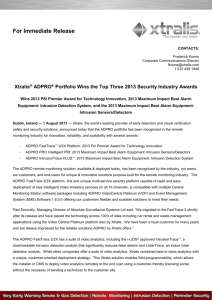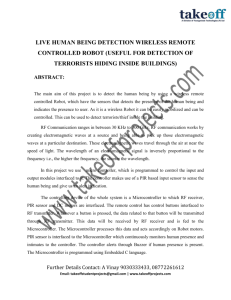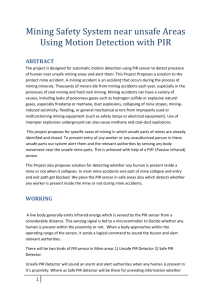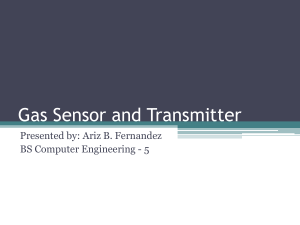Post-implementation reviews - Department of the Prime Minister and
advertisement
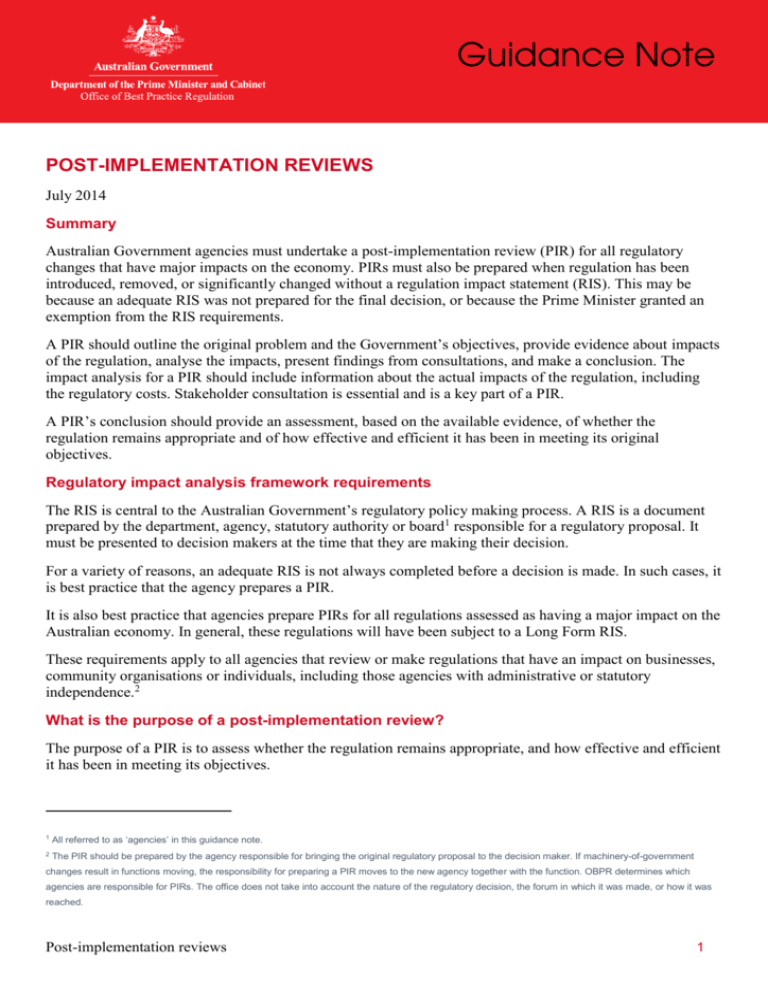
POST-IMPLEMENTATION REVIEWS July 2014 Summary Australian Government agencies must undertake a post-implementation review (PIR) for all regulatory changes that have major impacts on the economy. PIRs must also be prepared when regulation has been introduced, removed, or significantly changed without a regulation impact statement (RIS). This may be because an adequate RIS was not prepared for the final decision, or because the Prime Minister granted an exemption from the RIS requirements. A PIR should outline the original problem and the Government’s objectives, provide evidence about impacts of the regulation, analyse the impacts, present findings from consultations, and make a conclusion. The impact analysis for a PIR should include information about the actual impacts of the regulation, including the regulatory costs. Stakeholder consultation is essential and is a key part of a PIR. A PIR’s conclusion should provide an assessment, based on the available evidence, of whether the regulation remains appropriate and of how effective and efficient it has been in meeting its original objectives. Regulatory impact analysis framework requirements The RIS is central to the Australian Government’s regulatory policy making process. A RIS is a document prepared by the department, agency, statutory authority or board1 responsible for a regulatory proposal. It must be presented to decision makers at the time that they are making their decision. For a variety of reasons, an adequate RIS is not always completed before a decision is made. In such cases, it is best practice that the agency prepares a PIR. It is also best practice that agencies prepare PIRs for all regulations assessed as having a major impact on the Australian economy. In general, these regulations will have been subject to a Long Form RIS. These requirements apply to all agencies that review or make regulations that have an impact on businesses, community organisations or individuals, including those agencies with administrative or statutory independence.2 What is the purpose of a post-implementation review? The purpose of a PIR is to assess whether the regulation remains appropriate, and how effective and efficient it has been in meeting its objectives. 1 All referred to as ‘agencies’ in this guidance note. 2 The PIR should be prepared by the agency responsible for bringing the original regulatory proposal to the decision maker. If machinery-of-government changes result in functions moving, the responsibility for preparing a PIR moves to the new agency together with the function. OBPR determines which agencies are responsible for PIRs. The office does not take into account the nature of the regulatory decision, the forum in which it was made, or how it was reached. Post-implementation reviews 1 The Australian Government Guide to Regulation seeks to ensure that regulation has efficient outcomes and does not create an unnecessary burden of red tape for those affected by it. For this reason, if a regulatory change was not subject to scrutiny under the regulation impact analysis process at the pre-decision stage, it is necessary that it be subject to a PIR. It is also important for all regulatory decisions to be assessed within the same framework to ensure the ongoing quality of regulation. Regular reviews are useful for evaluating the ongoing performance of regulation, and the Office of Best Practice Regulation (OBPR) encourages agencies to review regulation following implementation even if a PIR is not required. Do you need to prepare a review? It is best practice to prepare a PIR if either of the following criteria apply: The regulatory proposal was noted as having a major economic impact by OBPR at the Preliminary Assessment stage of the regulation impact assessment process. An adequate RIS was not prepared for the final stage of the regulatory change, the change has affected businesses, community organisations or individuals, and the change was neither minor nor machinery in nature.3 The Guide to Regulation does not allow for any exemptions from the obligation to undertake and publish a PIR (in cases where one is required). If you are unsure whether or not you need to prepare a PIR based on these criteria, contact OBPR for formal advice. OBPR maintains a list of PIRs on its website, including information such as the due date for the review completion, the status of the review, and whether the agency is currently compliant with the PIR requirements. The office updates the list each quarter, as well as annually in the Best practice regulation report. Individual agency non-compliance with the PIR requirements is posted each quarter on the OBPR website. 3 The Guide to Regulation defines a minor change as one that does not substantially alter existing regulatory arrangements and a machinery change as a consequential change in regulation required as a result of a substantive regulatory decision. Post-implementation reviews 2 The regulation is already being reviewed for another process. Do I need to do a separate PIR? In some cases, regulation is subject to a statutory review provision written into the legislation. Alternatively, the policy may be subject to another review, such as a lapsing program review, close to the time when the PIR is required. You can draw on the work done for other reviews to meet some or all of the PIR requirements. In some cases, the other review can be assessed as meeting the PIR requirements without needing further work. However, the other review will still be assessed against the criteria for a PIR as set out in the Guide to Regulation. If you want OBPR to assess an alternative review as part of or in lieu of a stand-alone PIR, you should advise the office. Because PIRs need to be certified by the agency head or deputy head, your request should be accompanied by an appropriate approval. Process for conducting a review Start working on your PIR as soon as your regulation is implemented. Do not wait until just before the two-year deadline to start the work. You are responsible for gathering necessary data and consulting stakeholders during and after the implementation of the regulation. Start gathering data from the date the regulation is implemented. Draft the PIR in consultation with your portfolio Deregulation Unit, then submit it to OBPR for assessment. The office will advise you of any areas in the PIR that could be improved according to the best practice regulation principles. Once completed and assessed as adequate by OBPR, the PIR needs to be sent to the relevant portfolio minister and the Prime Minister. The PIR will then be published on the OBPR’s website. Some judgement is required in deciding when to start writing the PIR. You need to balance the requirement to gather sufficient data to be able to make robust conclusions against the need to identify and address inappropriate, non-performing or inefficient regulation through the review in a timely fashion. OBPR can provide technical assistance to help you determine whether or not you have enough information for an informative impact analysis. As a guideline, preparing the PIR report should take around three to six months once the relevant data has been gathered. Consultation with stakeholders is an essential source of information for the PIR. The timing guidelines do not prevent you from establishing strong stakeholder consultation arrangements at the earliest opportunity. Ideally, those arrangements would be in place before the implementation of the regulation in most cases. When does the review need to be completed? For regulations assessed by OBPR as having a major impact on the Australian economy, a PIR must be completed and signed off within five years following the implementation of the regulation. All other PIRs should be completed within two years of the regulations being implemented. These deadlines include the time required by OBPR to assess adequacy. You are responsible for allowing enough time to incorporate any changes suggested by the office during the assessment process. When setting milestones for the PIR in your forward work program, you should consider how the PIR might inform future decisions. OBPR maintains a register of outstanding PIRs and determines whether or not agencies are complying with best practice. Agencies will be asked annually to provide a written undertaking to OBPR that the PIRs for which the agency is responsible are included in its forward work program. OBPR will also consult you during the PIR process to ensure that the requirements for timely compliance are clear throughout. Post-implementation reviews 3 When is a policy considered to have been implemented? For some measures, particularly those that are extensive in scope, there may be some ambiguity about when the measure is considered to have been implemented. The date on which legislation or regulation passes the parliament, or a minister announces a regulatory change, might not be a useful proxy for the date of implementation. In consultation with agencies, OBPR determines the ‘implementation’ date when a regulation can be considered to have been implemented. The office determines the required timing for the PIR in order to maintain the integrity of the regulation impact assessment arrangements. The outcome will be reported on the OBPR website. What does the review need to include? This section outlines seven questions that the content in a PIR must address. There are some similarities between the seven RIS questions and the content that should be included in a PIR, but a PIR needs to have a greater focus on how well the regulation is achieving its original objectives. A PIR should assess whether the regulation remains appropriate, and how effective and efficient it has been in meeting its objectives. For the PIR to fulfil its purpose, you need to gather data about the functioning of the regulation over its entire lifespan. You also need to engage in effective consultation with affected stakeholders. You should consult OBPR to determine the extent of the analysis that will be needed. Your portfolio Deregulation Unit can also help. The PIR is not intended to be used as a means to critique or praise government policy. You should try to ensure that the evidence is gathered rigorously and presented in a balanced fashion in the PIR. Here are some tips for writing a good PIR: Give the PIR a logical structure and ensure that sections are clearly marked. This will make it easy to navigate. Keep it as free as possible from technical jargon. Include all relevant information. Be concise, ensuring that all the information in your PIR is relevant. Be transparent in your analysis by clearly differentiating between facts and anecdotal evidence. Check the accuracy of every claim. Where the data is inconclusive, say so. Be measured and prudent in your arguments and assertions. Examine and discuss whether or not the regulation continues to be appropriate for its purpose. Discuss the impacts (including the regulatory costs) on all stakeholders—businesses, community organisations and individuals. Describe the effect of government intervention in a way that helps readers understand whether or not the intended outcomes have been achieved efficiently. Provide a degree of detail in your analysis that is appropriate to the impacts of the regulation. The larger the impacts, the deeper the analysis should be. Post-implementation reviews 4 Present the analysis in a balanced fashion, accurately reporting the impacts (both positive and negative) and identifying any areas of uncertainty in your data. Report the views of all stakeholders in a balanced way. This includes acknowledging any views that are not supported by the available evidence. Draw logical conclusions based on the evidence and the strength of the data. Ensure that the document meets the Government’s commitment to web accessibility.4 Regulations, or the broader economic environment in which they operate, can change over time. Therefore, PIRs generally deal with one of three circumstances: the regulation has lapsed, or is about to lapse the regulation is continuing in its current form the regulation is to continue, but in a different form. The circumstances influence the nature of the PIR. For example, a ‘lessons learned’ PIR that is mainly backwards looking is suitable for a regulation that has lapsed. In other cases, it will be apparent by the time the PIR is being prepared that there is an ongoing need for the regulation, but that some aspect of it needs to be changed. This is likely to result in a new proposal for regulatory change, and a new RIS will usually be required. In such cases, the findings from the PIR will inform the decision about that RIS, and the PIR can be incorporated as part of the RIS. The precise nature of each PIR will also depend on the individual problem and regulations put in place to address that problem. The PIR may need to include other relevant information and discussion in addition to the above before OBPR can assess the review as adequate. Who is the intended audience for a PIR? A PIR is intended for both decision makers (for whom a balanced assessment of the performance of the regulation is critical) and stakeholders (who have a right to accurate, timely, accessible information about government decisions affecting them). The PIR will also be sent to the relevant portfolio minister and the Prime Minister after being assessed by OBPR, which will also publish the final PIR on its website. You are not required to structure the PIR in any particular way (for example, by using the criteria as headings). All that matters is that the information included in the review is sufficient to address each of the following questions. 4 The Australian Government has endorsed the Web Content Accessibility Guidelines (WCAG) version 2.0 for all government websites. More detail on the accessibility requirements is at http://webguide.gov.au/accessibility-usability/accessibility/. Post-implementation reviews 5 Question 1: What problem was the regulation meant to solve? Simply and clearly explain the problem that the regulation was intended to solve. Offer evidence about relevant market or regulatory failures before the introduction of the regulation and describe which businesses, community organisations or individuals were being most affected. Establish the magnitude of the problem. Provide background information to the regulatory intervention, including a description of any relevant previous regulatory arrangements and any evidence that they were not already addressing the problem. Questions on these topics to answer in the PIR could include the following. Market failure Was there evidence that one or more firms were abusing their position of market power? Was there a lack of reliable and easily accessible information about products, services or risks? Were there any externalities? What evidence suggested that the market would not resolve the problem over time? Regulatory failure What previous regulation failed to address the problem? What caused the previous regulation to fail? Is regulation still the most appropriate solution, given a prior failure to address the problem? Magnitude of the problem Was there a relatively high likelihood of a serious issue affecting a significant group in the economy? Was there a need to manage the risk of disaster? For example, would the costs of repair be so great that we would not be able to afford them? This is not to be an exhaustive list of questions. More information is on pages 18–19 of the Guide to Regulation. Question 2: Why was government action needed? Establish the case for direct intervention by government at the time of the regulatory decision. This includes any ex ante evidence showing that regulation would be likely to be effective in addressing the problem. Explain the objectives, outcomes, goals or targets of the regulatory intervention. Discuss any official announcements or media releases made by the relevant minister or the Prime Minister at the time of the decision to regulate. Where relevant, discuss the set of objectives stated in the Act associated with the change. More information is on pages 22–24 of the Guide to Regulation. Post-implementation reviews 6 Question 3: What policy options were considered? Include information on other viable policy options that were discussed in consultation or considered by decision makers as part of the decision to regulate, together with any reasons that can be published as to why the other options were not preferred. This includes any non-regulatory approaches that might have been used to achieve the objectives of the regulation. Provide background information on the various options (for example, the policy may have been an election commitment, or an option may have already been ruled out by previous political commitments). Discuss any options that were lobbied for or against by stakeholders. More information is on pages 26–29 of the Guide to Regulation. Question 4: What were the impacts of the regulation? Discuss the implementation of the regulation and its impacts on different groups, specifying all significant economic, social and environmental impacts on them and highlighting any differences in how various stakeholders are affected. Include information about the regulatory costs relating to the regulation. Those costs should be estimated in a manner consistent with the Regulatory Burden Measurement framework and agreed with OBPR. See the Regulatory Burden Measurement framework guidance note for more information. When reporting on the impacts of the regulation, the baseline for comparisons should be what is most likely to have happened if the regulatory change had not been made. (This is why it is critical that performance indicators are identified during the implementation of a regulation, allowing data on its efficiency and effectiveness to be collected from Day 1.) If the regulation was introduced in an area where regulations previously did not exist, the ‘no regulation’ scenario is the obvious baseline. If the regulatory change replaced one regulation with another, the situation under the earlier regulation is probably the best baseline. Even if it is difficult to identify the correct theoretical baseline, or if the most appropriate comparisons are very difficult, you will still need to set some benchmark against which the impacts of the regulation can be consistently measured. OBPR can provide technical assistance and help you to explore other options. The level of analysis in the PIR should be commensurate with the impacts of the measure: the greater the impacts, the more in-depth your analysis should be. More detailed analysis will usually need to be supported by stronger evidence. What if some relevant information is no longer available? Because of the delay between the decision to introduce a regulation and the preparation of the PIR, the original decision maker might no longer be the current decision maker. Staff turnover may mean that corporate memory about a decision is limited. If your information is limited, make that transparent in the PIR. Cover a period from the introduction of the regulation until the present or the time when the regulation lapsed (where the regulation has ceased to operate). Post-implementation reviews 7 Analyse both the costs and the benefits of the regulation. This analysis should: focus on outcomes since implementation assess the costs and benefits based on data gathered from consultation or from independent sources, such as the Australian Bureau of Statistics assess the impacts on businesses, community organisations or individuals, including distributional issues such as the impact on small business assess the net impact of the regulation on the community as a whole, taking into account all costs and benefits and the distribution of those costs and benefits quantify (for example, through consultation, surveys, or both) the effect of the regulation on compliance costs for businesses, community organisations or individuals recognise the effect of the regulation on individuals and the cumulative burden on businesses and community organisations note any significant changes to the level of competition since the regulation was introduced (for example, new suppliers entering the market, or a number of small businesses leaving the sector). The analysis should be a balanced presentation of the costs and benefits. Even if a full quantitative cost–benefit analysis is not possible, your PIR should still quantify those costs and benefits that can be measured and analyse the material impacts of the regulation on the main stakeholders. You must also quantify the regulatory costs of regulation to businesses, community organisations or individuals, consistent with the Regulatory Burden Measurement framework. See the Cost–benefit analysis guidance note for more information on conducting a cost–benefit analysis. Government will almost always be a stakeholder in any regulation. Therefore, you should also consider any enforcement issues highlighted by the regulator during implementation or identified by other stakeholders during consultations. Describe any unintended consequences of the regulation. Say why they occurred, what impacts they had, and whether they enhanced or reduced the regulation’s effectiveness. In some cases, it may be necessary or appropriate to suggest ways to change the regulation, or to put forward other nonregulatory methods to address problems that have arisen. Post-implementation reviews 8 How extensive should the analysis be? Best practice for analysis varies from review to review. In general, the greater the impacts of the regulation, the more extensive your analysis should be. The level of quantification in the analysis will depend on data availability, but you need to quantify at least the regulatory costs. Effective consultation with stakeholders soon after implementation should help you to obtain relevant data. However, you should not expect them to be able to give you exact figures for regulatory costs, which you may have to determine from a range of information sources. As a guide, you should consider productivity impacts; benefits to businesses, consumers, governments and other affected groups; regulatory costs for businesses, community organisations and individuals; and any other costs to consumers or the community. Discuss the distribution of the costs and benefits, including jurisdictional differences where they are relevant. Question 5: Which stakeholders have been consulted? Your PIR process should incorporate consultation with relevant stakeholders on the impacts of the regulation, including competition impacts and the regulatory costs. This consultation should be in line with that detailed in the Guide to Regulation and the Best practice consultation guidance note. As with the analysis, the level of consultation should be commensurate with the significance of the measure under review. It may be more efficient for you to gather the necessary data for PIR analysis as part of an ongoing consultation starting during the implementation phase. The PIR needs to describe how consultation was conducted (including when it was undertaken, the timeframes and the methods). You should articulate the views of those consulted, highlighting any substantial differences between the views or experiences of different stakeholders. Your ministerial advisory council must be consulted during the preparation of a PIR. As peak members of the affected industry, they will be able to give you valuable suggestions and feedback on the performance of the regulation. They are also likely to be able to assist you in establishing a broad consultation network across the regulated sector. Question 6: Has the regulation delivered a net benefit? Provide an assessment of whether the regulation has delivered a net benefit for the community. Has the change been positive for the community? You should also make an assessment of the ongoing appropriateness, effectiveness and efficiency of the regulation in addressing the problem and achieving the regulation’s stated objectives. This statement needs to be supported by a balanced assessment of the evidence presented elsewhere in the PIR. In some cases, isolating the impact of a single regulatory change will not be possible, given other influences on outcomes. In such cases, it is reasonable, and possibly desirable, to conclude and state that it is not possible to draw definitive conclusions. Post-implementation reviews 9 If the regulatory change has restricted competition, you must assess whether or not it has generated a net benefit to the community as a whole. You should also consider whether or not the restrictions on competition have been essential to achieving the Government’s objectives. The PIR should also include these findings on competition impacts as part of its conclusion. It is essential that your conclusions about the impacts and effectiveness of the regulation align with the evidence presented in your PIR. Using consultants for PIRs Agencies may wish to employ consultants to help prepare PIRs, particularly where the analysis of highly complex issues requires expertise not available within the agency. While this can improve the quality of the analysis in the PIR, it can also reduce the depth of policy expertise developed within the agency. The main objective of the PIR process is to assess the appropriateness, effectiveness and efficiency of the regulation. Where this role is outsourced, there is a risk that the agency will not develop the depth of knowledge needed to give decision makers the best possible advice on any future changes to the regulation. The PIR remains the responsibility of the agency even if consultants are used. However, OBPR can hold joint consultations with both parties to help ensure that the final PIR is adequate. Question 7: How was the regulation implemented and evaluated? Your PIR should record the implementation plan and note any lessons learned from the implementation of the regulation. You should also summarise any review processes used to monitor the performance of the regulation, other than the PIR. Not meeting best practice OBPR uses a range of methods to assist agencies in drafting PIRs and to inform them and others about whether the PIRs meet best practice, including: writing to agencies outlining areas of concern and suggested remedies briefing the Prime Minister on areas of concern briefing Cabinet on areas of concern publishing information on areas of concern determining non-compliance with the PIR requirements and publishing that information. To encourage agencies to produce PIRs that meet best practice, OBPR will usually rely on the first four options above. This is also consistent with the fact that the PIR process is primarily the responsibility of the agency. OBPR reports on compliance with the Government’s RIS requirements, including PIRs, on its website and annually in the Best practice regulation report. Exemptions cannot be obtained for PIRs. Therefore, to avoid being reported as non-compliant with the Government’s PIR requirements, you need to devote sufficient resources to prepare an adequate PIR within the required timeframe. For further information on any of the topics covered in this guidance note, contact OBPR on (02) 6271 6270 or at helpdesk-OBPR@pmc.gov.au. Post-implementation reviews 10 Appendix 1: Frequently asked questions Why do we need post-implementation reviews? Regulation can have benefits, but businesses, community organisations and individuals pay the price of poor regulation. The PIR is part of a systematic approach to regulation that helps the Government ensure that new regulations remain appropriate and that they are efficient and effective in achieving the intended outcomes. The regulation has lapsed. Do I still need to prepare a PIR? Yes. What if regulations have been amended from those initially implemented? If the regulation has undergone changes since implementation, a PIR is still required unless the impact is of a minor or machinery nature. There may have been changes to the nature or objectives of the regulation. In such cases, the changes should be described in the PIR. Adequately describing the changes and the reasons they occurred is an important part of meeting the best practice criteria for PIRs. Any new proposal to amend regulation may warrant a RIS unless the changes are of a minor or machinery nature. Where a RIS is required for the amendments, agencies have the option of addressing the PIR through the RIS for the amendments. Is there any way to get an exemption from doing a PIR? No. Post-implementation reviews 11
